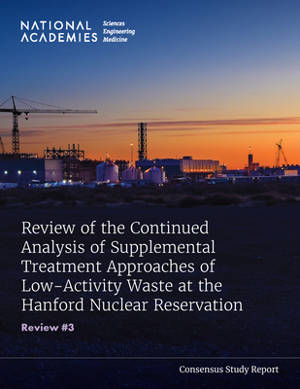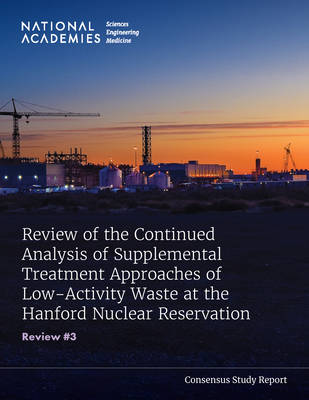
- Retrait gratuit dans votre magasin Club
- 7.000.000 titres dans notre catalogue
- Payer en toute sécurité
- Toujours un magasin près de chez vous
- Retrait gratuit dans votre magasin Club
- 7.000.0000 titres dans notre catalogue
- Payer en toute sécurité
- Toujours un magasin près de chez vous
Review of the Continued Analysis of Supplemental Treatment Approaches of Low-Activity Waste at the Hanford Nuclear Reservation
Review #3
National Academies of Sciences Engineering and Medicine, Division on Earth and Life Studies, Nuclear and Radiation Studies Board, Committee on Supplemental Treatment of Low-Activity Waste at theDescription
The Hanford Nuclear Reservation in the state of Washington produced about two-thirds of the nations plutonium for nuclear weapons from 1944 until the last reactor was shut down in 1987. The U.S. Department of Energy Office of Environmental Management (DOE-EM) manages the ongoing clean-up at Hanford and has built a plant to convert the high-level radioactive waste into a glass form (vitrification) for safe disposal. However, decisions remain about how best to treat and dispose of the low-level waste at Hanford, which comprises over 90% of the volume of waste. To inform its decision, DOE contracted with key Federally Funded Research and Development Centers (FFRDC), led by Savannah River National Laboratory, to carry out an analysis. This final in a trilogy of reports from the National Academies reviews the FFRDC third report released in January 2023.
The review finds that the FFRDC team made a strong technical case that converting the supplemental low-level waste from the vitrification process to a grout form (like cement) is the best option in terms of cost-effectiveness and timeliness, and that off-site disposal of that grout is a valid option as it will be away from potable water. The FFRDC provided a useful framework to help decision-makers understand the issues and trade-offs of the disposal options and did an excellent job of isolating specific factual considerations that can be analyzed, often quantified, and compared with each other. The FFRDC chose to provide a purely technical analysis that excluded analysis of two important factors to be considered - securing regulatory permissions and public acceptance - treating them, for now, as uncertainties. Looking ahead, the DOE faces many uncertainties and should emphasize flexibility in its overall approach, allowing for multiple, redundant options and pathways, as well as the ability to change over time.
Spécifications
Parties prenantes
- Auteur(s) :
- Editeur:
Contenu
- Nombre de pages :
- 80
- Langue:
- Anglais
Caractéristiques
- EAN:
- 9780309699730
- Date de parution :
- 10-08-23
- Format:
- Livre broché
- Format numérique:
- Trade paperback (VS)
- Dimensions :
- 216 mm x 279 mm

Les avis
Nous publions uniquement les avis qui respectent les conditions requises. Consultez nos conditions pour les avis.






